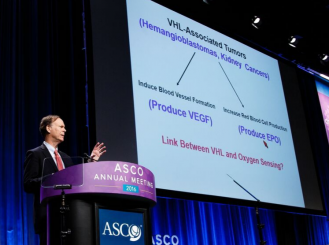Oct 07, 2019
On October 7, the Nobel Assembly at Karolinska Institutet announced that the 2019 Nobel Prize in Physiology or Medicine would be jointly awarded to William G. Kaelin Jr., MD, Sir Peter J. Ratcliffe, FRS, and Gregg L. Semenza, MD, PhD, for their discoveries of how cells sense and adapt to oxygen availability.
“The seminal discoveries by this year’s Nobel Laureates revealed the mechanism for one of life’s most essential adaptive processes. They established the basis for our understanding of how oxygen levels affect cellular metabolism and physiological function. Their discoveries have also paved the way for promising new strategies to fight anemia, cancer and many other diseases,” according to the Nobel Assembly press release.
Dr. Kaelin, of Harvard Medical School and Dana-Farber Cancer Institute, is being honored for his research on the familial cancer syndrome von Hippel-Lindau disease (VHL). Dr. Kaelin discovered that the VHL gene encodes a protein that prevents the onset of cancer; he found that cancer cells lacking a functional VHL gene express abnormally high levels of hypoxia-regulated genes, but when the VHL gene was reintroduced into cancer cells, normal levels were restored. This indicated that VHL was involved in controlling responses to hypoxia.
In 2016, Dr. Kaelin received the ASCO Science of Oncology Award and Lecture for his groundbreaking work in VHL, particularly for his investigations into the VHL protein, which led to the successful development of VEGF inhibitors in kidney cancer.
Dr. Semenza, of Johns Hopkins University, investigated the EPO gene and how it is regulated by oxygen levels, and discovered the hypoxia-inducible factor (HIF), a protein complex that binds to the identified DNA segment in an oxygen-dependent manner. His research identified the genes encoding HIF, and HIF was found to consist of two transcription factors, HIF-1α and ARNT.
Dr. Ratcliffe, of the Francis Crick Institute, London, and the Target Discovery Institute at Oxford, also studied O2-dependent regulation of the EPO gene, and made the key discovery that VHL can physically interact with HIF-1α and is required for its degradation at normal oxygen levels, conclusively linking VHL to HIF-1α.
To elucidate how O2 levels regulate the interaction between VHL and HIF-1α, both Dr. Kaelin and Dr. Ratcliffe suspected that the key to O2-sensing resided in a portion of the HIF-1α protein known to be important for VHL-dependent degradation. In 2001, in two simultaneously published papers, they identified prolyl hydroxylation, a protein modification that allows VHL to recognize and bind to HIF-1α, and thus explained how normal oxygen levels control rapid HIF-1α degradation with the help of oxygen-sensitive enzymes (prolyl hydroxylases). Further research by Dr. Ratcliffe and others identified the responsible prolyl hydroxylases.
ASCO congratulates Dr. Kaelin, Dr. Semenza, and Dr. Ratcliffe on this well-deserved recognition.
In 2018, ASCO member and immunotherapy pioneer Dr. James P. “Jim” Allison was named as a Nobel laureate, an honor he shared with Dr. Tasuku Honjo.

